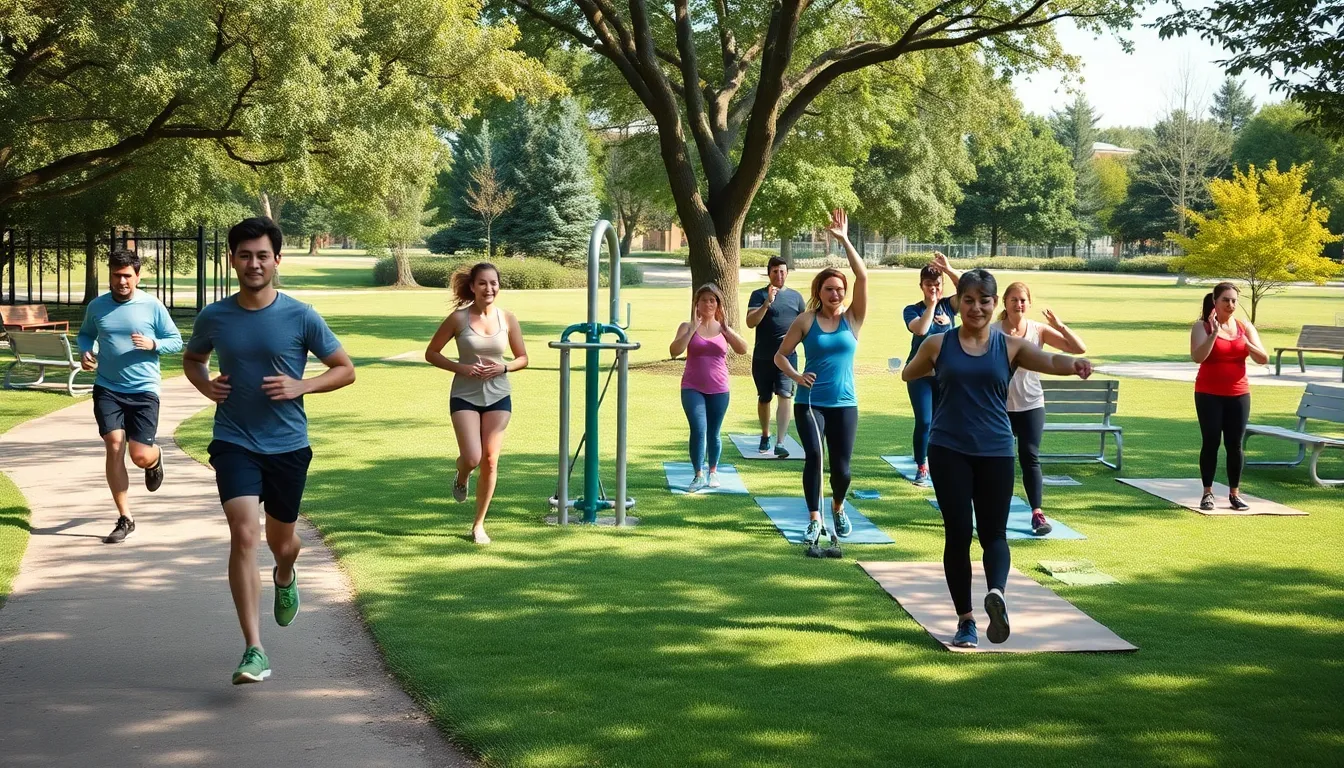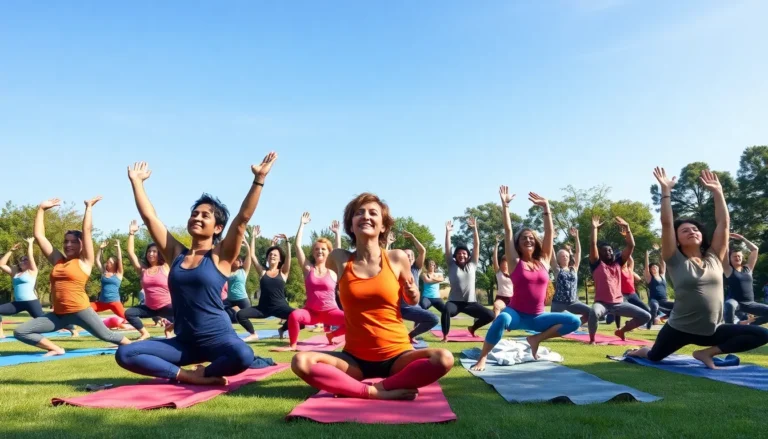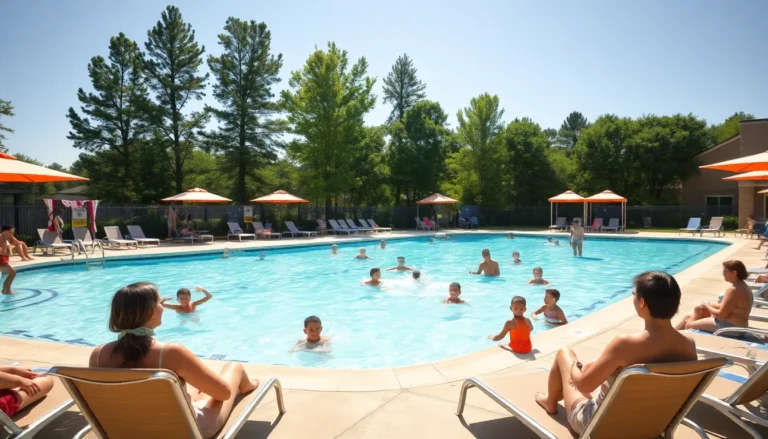Table of Contents
ToggleImagine a place where getting fit feels less like a chore and more like a fun outing. Welcome to the world of fitness parks! These outdoor gems blend nature with exercise, offering everything from climbing walls to obstacle courses. They’re not just for hardcore athletes; they cater to everyone, from weekend warriors to those just starting their fitness journey.
Overview of Fitness Parks
Fitness parks serve as outdoor environments that encourage physical activity through fun and engaging installations. These parks often feature equipment such as climbing walls, obstacle courses, and fitness zones tailored for various skill levels. Individuals can find activities suitable for beginners as well as advanced athletes.
Locations typically integrate natural surroundings, enhancing the experience while promoting wellness. Community engagement plays a vital role in these parks, welcoming social interactions among users. Furthermore, fitness parks foster inclusivity, allowing people of all ages and abilities to participate in exercise.
Access to fitness parks remains a significant benefit, as they often do not require fees. Convenience stands out, with many parks situated within local neighborhoods or community areas, making them easily reachable for most residents. Safety measures, such as well-maintained equipment and clear signage, contribute to a secure environment for workouts.
Variety enriches the opportunities available, with options ranging from yoga zones to strength-training areas. Routine physical activity in these parks can lead to improved mental health, making fitness feel less like an obligation. People may establish connections with others who share similar health goals, fostering a supportive community atmosphere.
Overall, fitness parks exemplify innovative approaches to exercise by merging outdoor enjoyment with wellness activities. The inclusion of diverse fitness options appeals to a wide audience, enhancing participation and promoting healthier lifestyles. Embracing these outdoor spaces leads to greater community involvement and encourages a culture of fitness.
Benefits of Fitness Parks

Fitness parks offer numerous advantages that contribute to overall well-being. They support various aspects of physical and mental health through engaging outdoor activities.
Physical Health Advantages
Fitness parks enhance cardiovascular health through activities like jogging and cycling. They provide strength-training equipment that helps build muscle and improve endurance. Engaging in diverse exercises in these parks promotes flexibility and coordination along with reducing the risk of chronic diseases. Outdoor workouts benefit from fresh air, encouraging individuals to exercise more regularly. They cater to all fitness levels, allowing novices and experienced athletes to find suitable options. Regular visits can lead to weight management and improved body composition.
Mental Health Benefits
Fitness parks positively impact mental well-being through social interaction and support. Exercising outdoors enhances mood and decreases feelings of stress and anxiety. Engaging in physical activity releases endorphins, contributing to a more positive outlook on life. Community events at fitness parks foster connections between individuals with shared goals, creating a sense of belonging. Nature’s calming presence aids in reducing mental fatigue and promotes relaxation during workouts. Diverse activities stimulate engagement and alleviate boredom, further supporting mental health.
Popular Features of Fitness Parks
Fitness parks offer diverse features that enhance the exercise experience. Engaging installations attract individuals of all fitness levels, creating welcoming spaces for community wellness.
Outdoor Gym Equipment
Durable outdoor gym equipment provides various exercise opportunities. Users find stations for strength training, cardio workouts, and stretching. Equipment often includes pull-up bars, benches, and resistance machines. These installations facilitate workouts in a natural setting, encouraging physical activity without the constraints of a traditional gym. Functional designs allow for individual workouts or group exercises, promoting social connections among users. Many fitness parks also ensure that equipment is accessible to all, enhancing inclusivity.
Walking and Running Trails
Scenic walking and running trails form another essential feature of fitness parks. Trails typically range from 0.5 to several miles, suitable for leisurely strolls or intense jogging sessions. Frequently winding through green spaces, these paths encourage exploration and interaction with nature. Various terrains, including gravel and paved surfaces, cater to different preferences. Regularly using these trails can improve cardiovascular fitness and mental well-being. Community members often join together, creating a supportive environment that motivates individuals to stay active.
Community Impact of Fitness Parks
Fitness parks significantly influence the communities they serve by fostering social connections and promoting healthier lifestyles. These spaces encourage people to engage both physically and socially within their neighborhoods.
Promoting Social Interaction
Shared spaces in fitness parks serve as natural gathering points. Individuals often meet others through group classes or casual workouts. Diverse fitness programs attract various groups and establish a sense of community. Relationships formed in these parks enhance social bonds and support, which benefit mental health. People participating in group activities often find motivation and accountability through shared goals. This collaborative environment fosters friendships that extend beyond fitness. These connections create a welcoming atmosphere for newcomers.
Encouraging Healthy Lifestyles
Fitness parks play a vital role in encouraging active living. Access to diverse workout options promotes regular physical activity among all age groups. Encouragement comes from seeing others exercising and enjoying the outdoors, inspiring individuals to join in. The variety of equipment supports strength training, cardiovascular health, and flexibility exercises. Community events held in these parks often focus on healthy living, further motivating attendees. Research shows that outdoor exercise carries physical and mental health benefits, enhancing overall well-being. Individuals participating in these activities notice improvements in mood and reductions in stress levels. Such environments emphasize the importance of integrating fitness into daily routines.
Tips for Making the Most of Fitness Parks
Maximize your experience at fitness parks by arriving with a plan. Determine specific workouts or activities that align with personal fitness goals. Explore various zones, including strength and cardio areas, to diversify routines.
Engage in group classes offered in these parks. Participating in group activities fosters community engagement and enhances motivation. Discover new workouts and techniques while making social connections.
Use available equipment correctly to prevent injuries. Familiarize yourself with safe practices and adjustments to suit individual fitness levels. Refer to signage for guidance on proper usage and techniques.
Rotate through different fitness stations to maintain excitement. Alternate between cardio, strength, and flexibility exercises to avoid monotony. Incorporating various activities can lead to improved overall performance.
Stay hydrated while exercising. Keep a water bottle close at hand to replenish fluids during workouts. Staying hydrated is essential for sustained energy and optimal performance.
Schedule workouts during quieter times if possible. Fewer crowds make it easier to access equipment and enjoy a more personalized experience. Check local trends for peak hours to plan effectively.
Participate in community events held at fitness parks. These events often provide additional resources, such as wellness workshops or fitness challenges. Engaging with others can inspire new fitness pursuits and create lasting connections.
Take advantage of natural surroundings during workouts. Utilize scenic trails for activities like walking or jogging to enjoy the calming effects of nature. Incorporating outdoor elements enhances the overall fitness experience.
Finally, track progress to stay motivated. Keeping a journal or using fitness apps helps monitor achievements and set new goals. Recognizing personal improvements reinforces commitment to a healthy lifestyle.
Fitness parks stand out as vibrant spaces that transform exercise into an enjoyable experience. With their diverse offerings and natural settings, they invite people of all fitness levels to engage in physical activity while fostering community connections. The accessibility and variety of equipment encourage individuals to explore different workouts and maintain a consistent fitness routine.
These parks not only enhance physical health but also contribute significantly to mental well-being. By providing a supportive atmosphere, they help to build friendships and promote a sense of belonging. As more communities embrace fitness parks, they pave the way for healthier lifestyles and stronger social bonds, making fitness an integral part of daily life.







